highspeedship高性能船舶
- 格式:doc
- 大小:52.00 KB
- 文档页数:6
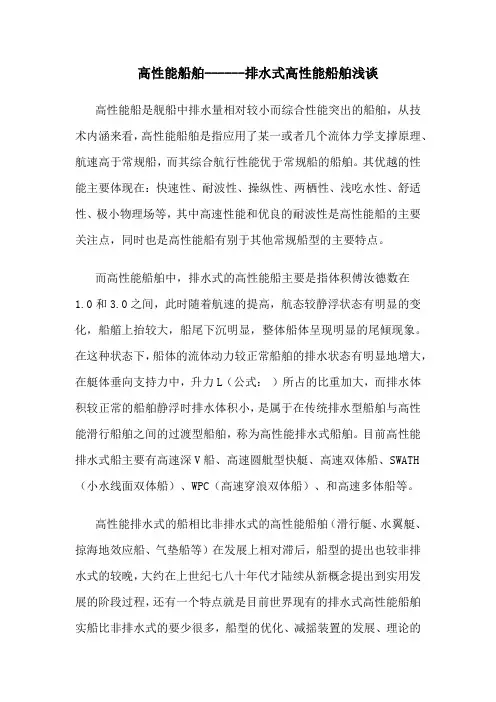
高性能船舶------排水式高性能船舶浅谈高性能船是舰船中排水量相对较小而综合性能突出的船舶,从技术内涵来看,高性能船舶是指应用了某一或者几个流体力学支撑原理、航速高于常规船,而其综合航行性能优于常规船的船舶。
其优越的性能主要体现在:快速性、耐波性、操纵性、两栖性、浅吃水性、舒适性、极小物理场等,其中高速性能和优良的耐波性是高性能船的主要关注点,同时也是高性能船有别于其他常规船型的主要特点。
而高性能船舶中,排水式的高性能船主要是指体积傅汝德数在1.0和3.0之间,此时随着航速的提高,航态较静浮状态有明显的变化,船艏上抬较大,船尾下沉明显,整体船体呈现明显的尾倾现象。
在这种状态下,船体的流体动力较正常船舶的排水状态有明显地增大,在艇体垂向支持力中,升力L(公式:)所占的比重加大,而排水体积较正常的船舶静浮时排水体积小,是属于在传统排水型船舶与高性能滑行船舶之间的过渡型船舶,称为高性能排水式船舶。
目前高性能排水式船主要有高速深V船、高速圆舭型快艇、高速双体船、SWATH (小水线面双体船)、WPC(高速穿浪双体船)、和高速多体船等。
高性能排水式的船相比非排水式的高性能船舶(滑行艇、水翼艇、掠海地效应船、气垫船等)在发展上相对滞后,船型的提出也较非排水式的较晚,大约在上世纪七八十年代才陆续从新概念提出到实用发展的阶段过程,还有一个特点就是目前世界现有的排水式高性能船舶实船比非排水式的要少很多,船型的优化、减摇装置的发展、理论的进一步完善都处于发展当中,同时尽管发展的相对较晚,但是发展速度有目共睹,其中高速穿浪双体船的概念仅仅刚提出,在随后的十年当中发展迅猛,澳大利亚等国已把相对成熟的WPC技术应用到了大型船舶当中。
排水式高性能船舶发展之所以如此之快,受人瞩目是有其突出的几个特点的。
这些高性能船舶各具特色,各有优缺点。
如高速单体船的优点是船型、布置、建造等简单方便,在中速时有较高的升阻比,但缺点是在波浪中砰击大,垂向加速度高,稳性差,高速时升阻比小,甲板面积小等。
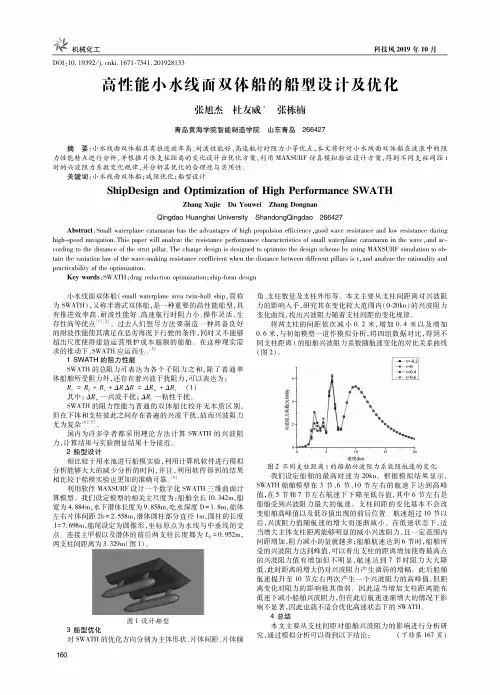
机械化工科技风2019年10月DO#10.19392/k>1671-7341.201928133高性能小水线面双体船的船型设计及优化张旭杰杜友威!张栋楠青岛黄海学院智能制造学院山东青岛266427摘要:小水线面双体船具有推进效率高、耐波性能好、高速航行时阻力小等优点,本文将针对小水线面双体船在波浪中的阻力性能特点进行分析,并根据片体支柱距离的变化设计出优化方案,利用MAXSURF仿真模拟验证设计方案,得到不同支柱间距t 时的兴波阻力系数变化规律,并分析其优化的合理性与实用性。
关键词:小水线面双体船;减阻优化;船型设计ShipDesign and Optimization of High Performance SWATHZhang Xujiz Du Youwei Zhang DongnanQingdao Huanghai University ShandongQingdao266427Abstract:Small waterplane catamaran has the advantages of high propulsion efficiency,good wave resistancc and low resistancc during high-speed navigation.This paper will analyze the resistancc performancc chaocteOstics of small waterplane catamaran in the wave,and ac-ccrding ta the distancc of the strut pilar.The change design is designed ta optimiee the design scheme by using MAXSURF simulation ta obtain the veriation law of the wave-making resistancc coefficient when the distancc between dOferent卩:100is t,and analyee the otionality and peacaicabiaiazooaheopaimieaaion.Key word:SWATH;deg reduction optimization;ship-form design小水线面双体船(small waterplane aree twin-hull ship,简称为SWATH),又称半潜式双体船,是一种重要的高性能船型,具有推进效率高、耐波性能好、高速航行时阻力小、操作灵活、生存性高等优点⑴⑵#过去人们想尽方法要制造一种具备良好的耐波性能使其满足在恶劣海况下行驶的条件,同时又不能够超出尺度使得建造运营维护成本超额的船舶。
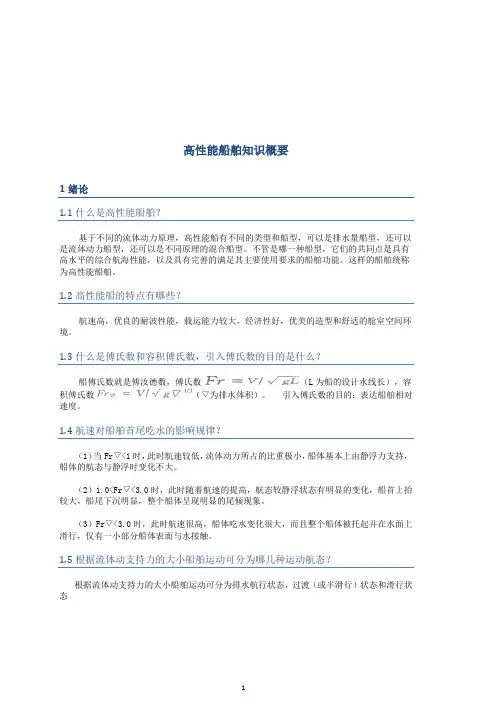
高性能船舶知识概要1绪论1.1什么是高性能船舶?基于不同的流体动力原理,高性能船有不同的类型和船型,可以是排水量船型,还可以是流体动力船型,还可以是不同原理的混合船型。
不管是哪一种船型,它们的共同点是具有高水平的综合航海性能,以及具有完善的满足其主要使用要求的船舶功能。
这样的船舶统称为高性能船舶。
1.2高性能船的特点有哪些?航速高,优良的耐波性能,载运能力较大,经济性好,优美的造型和舒适的舱室空间环境。
1.3什么是傅氏数和容积傅氏数,引入傅氏数的目的是什么?船傅氏数就是傅汝德数,傅氏数(L为船的设计水线长),容积傅氏数(▽为排水体积)。
引入傅氏数的目的:表达船舶相对速度。
1.4航速对船舶首尾吃水的影响规律?(1)当Fr▽<1时,此时航速较低,流体动力所占的比重极小,船体基本上由静浮力支持,船体的航态与静浮时变化不大。
(2)1.0<Fr▽<3.0时,此时随着航速的提高,航态较静浮状态有明显的变化,船首上抬较大,船尾下沉明显,整个船体呈现明显的尾倾现象。
(3)Fr▽<3.0时,此时航速很高,船体吃水变化很大,而且整个船体被托起并在水面上滑行,仅有一小部分船体表面与水接触。
1.5根据流体动支持力的大小船舶运动可分为哪几种运动航态?根据流体动支持力的大小船舶运动可分为排水航行状态,过渡(或半滑行)状态和滑行状态1.6高性能船舶有哪几种类型?高性能船舶主要包括:小水线面双体船,穿浪双体船,滑行船,水翼艇,气垫船,地效翼船,高性能排水式单体船。
1.7高性能船舶航行性能有哪几种研究方法,这些方法的特点是什么?高性能船舶航行性能有三种研究方法:理论计算研究,模型试验研究,实船试验研究,特点如下:理论计算研究特点,高性能船舶是现代高科技应用和发展的产物。
在每种高性能新船型开发研制工作一开始,以船舶水动力学为基础的各种分析计算方法即被引用于性能研究工作,而且收到了比单体船性能研究中使用理论计算方法更好的效果。
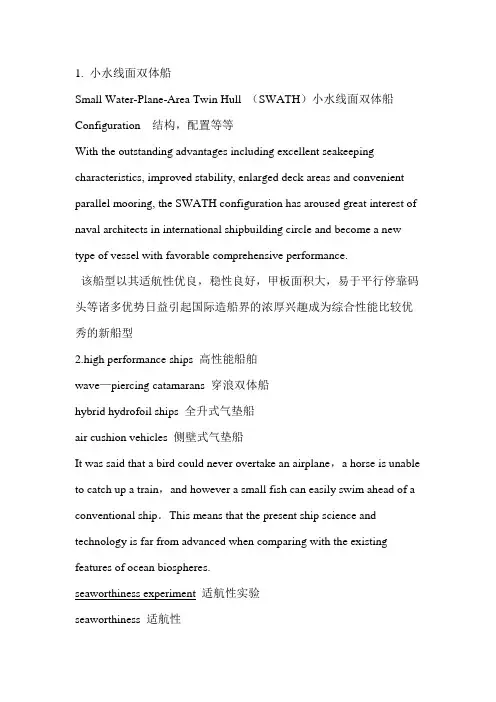
1. 小水线面双体船Small Water-Plane-Area Twin Hull (SWATH)小水线面双体船Configuration 结构,配置等等With the outstanding advantages including excellent seakeeping characteristics, improved stability, enlarged deck areas and convenient parallel mooring, the SWATH configuration has aroused great interest of naval architects in international shipbuilding circle and become a new type of vessel with favorable comprehensive performance.该船型以其适航性优良,稳性良好,甲板面积大,易于平行停靠码头等诸多优势日益引起国际造船界的浓厚兴趣成为综合性能比较优秀的新船型2.high performance ships 高性能船舶wave—piercing catamarans 穿浪双体船hybrid hydrofoil ships 全升式气垫船air cushion vehicles 侧壁式气垫船It was said that a bird could never overtake an airplane,a horse is unable to catch up a train,and however a small fish can easily swim ahead of a conventional ship.This means that the present ship science and technology is far from advanced when comparing with the existing features of ocean biospheres.seaworthiness experiment 适航性实验seaworthiness 适航性warranty of seaworthiness 适航性保障It was there in China that almost all types of high performance ships were studied since 1950s,ranging from wing in ground effectvehicle(WIGs),hydrofoil vessels,air cushion vehicles(SCVs),surface effect ships(SESs),small waterplane area twin hullships(SW ATH),wave piercing twin-hull ships,high-speed muhi—hull ships,and hybrid hydrofoilships,地效应飞机水翼船气垫船侧壁式气垫船小水线面双体船穿浪双体船高速多体船水翼复合船DWT 载重公吨位(deadweight ton)WPC wave piercing catamaran 穿浪双体船应用帐篷函数和二次型数学规划优化法Fin 减摇鳍玻璃纤维增强塑料(Fiber Reintoreed PIBstics)简称玻璃钢(FRP)游艇中世界上2 000万艘6~20 m的游艇中,FRP游艇占r 90“以r。
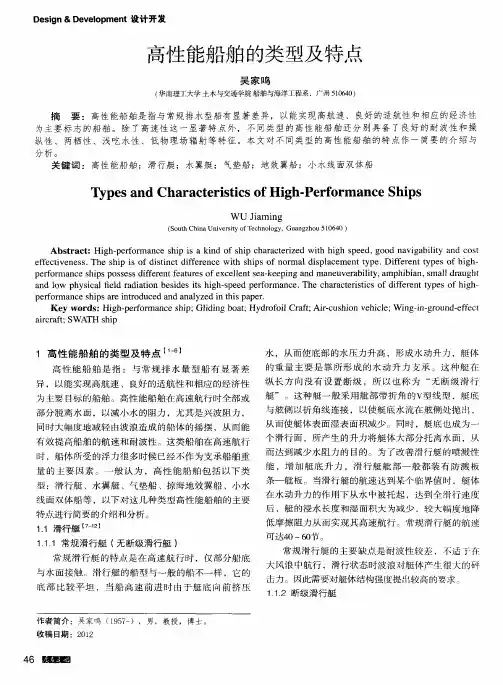
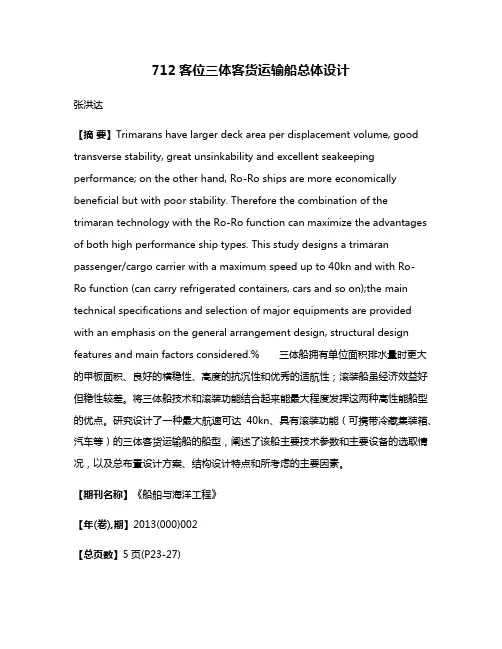
712客位三体客货运输船总体设计张洪达【摘要】Trimarans have larger deck area per displacement volume, good transverse stability, great unsinkability and excellent seakeeping performance; on the other hand, Ro-Ro ships are more economically beneficial but with poor stability. Therefore the combination of the trimaran technology with the Ro-Ro function can maximize the advantages of both high performance ship types. This study designs a trimaran passenger/cargo carrier with a maximum speed up to 40kn and with Ro-Ro function (can carry refrigerated containers, cars and so on);the main technical specifications and selection of major equipments are provided with an emphasis on the general arrangement design, structural design features and main factors considered.% 三体船拥有单位面积排水量时更大的甲板面积、良好的横稳性、高度的抗沉性和优秀的适航性;滚装船虽经济效益好但稳性较差。
将三体船技术和滚装功能结合起来能最大程度发挥这两种高性能船型的优点。
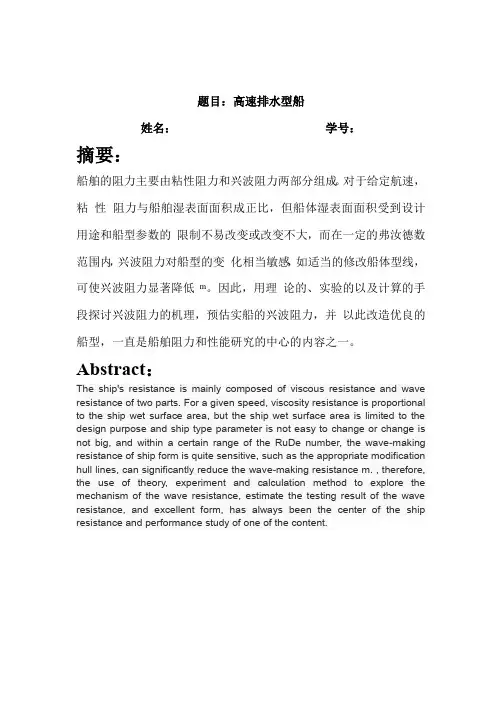
题目:高速排水型船姓名:学号:摘要:船舶的阻力主要由粘性阻力和兴波阻力两部分组成。
对于给定航速,粘性阻力与船舶湿表面面积成正比,但船体湿表面面积受到设计用途和船型参数的限制不易改变或改变不大,而在一定的弗汝德数范围内,兴波阻力对船型的变化相当敏感,如适当的修改船体型线,可使兴波阻力显著降低m。
因此,用理论的、实验的以及计算的手段探讨兴波阻力的机理,预估实船的兴波阻力,并以此改造优良的船型,一直是船舶阻力和性能研究的中心的内容之一。
Abstract:The ship's resistance is mainly composed of viscous resistance and wave resistance of two parts. For a given speed, viscosity resistance is proportional to the ship wet surface area, but the ship wet surface area is limited to the design purpose and ship type parameter is not easy to change or change is not big, and within a certain range of the RuDe number, the wave-making resistance of ship form is quite sensitive, such as the appropriate modification hull lines, can significantly reduce the wave-making resistance m. , therefore, the use of theory, experiment and calculation method to explore the mechanism of the wave resistance, estimate the testing result of the wave resistance, and excellent form, has always been the center of the ship resistance and performance study of one of the content.背景:船舶的大型化、高速化是现代水路交通发展的趋势之一,这是运输业追求高效率的必然结果。
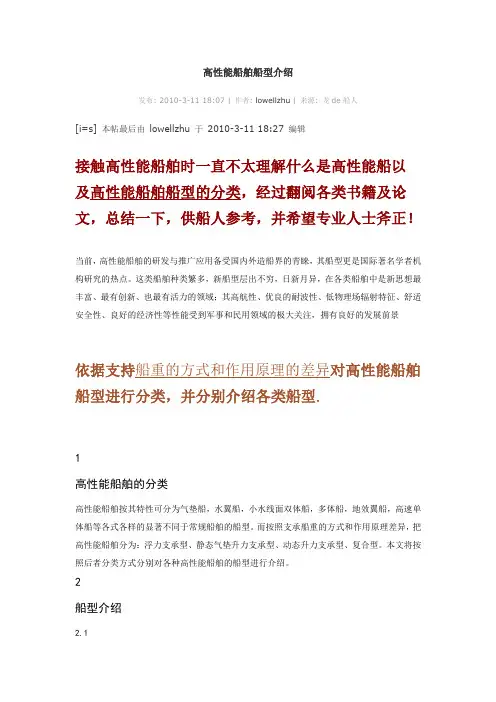
高性能船舶船型介绍发布: 2010-3-11 18:07 | 作者: lowellzhu | 来源: 龙de船人[i=s] 本帖最后由lowellzhu 于2010-3-11 18:27 编辑接触高性能船舶时一直不太理解什么是高性能船以及高性能船舶船型的分类,经过翻阅各类书籍及论文,总结一下,供船人参考,并希望专业人士斧正!当前,高性能船舶的研发与推广应用备受国内外造船界的青睐,其船型更是国际著名学者机构研究的热点。
这类船舶种类繁多,新船型层出不穷,日新月异,在各类船舶中是新思想最丰富、最有创新、也最有活力的领域;其高航性、优良的耐波性、低物理场辐射特征、舒适安全性、良好的经济性等性能受到军事和民用领域的极大关注,拥有良好的发展前景依据支持船重的方式和作用原理的差异对高性能船舶船型进行分类,并分别介绍各类船型。
1高性能船舶的分类高性能船舶按其特性可分为气垫船,水翼船,小水线面双体船,多体船,地效翼船,高速单体船等各式各样的显著不同于常规船舶的船型。
而按照支承船重的方式和作用原理差异,把高性能船舶分为:浮力支承型、静态气垫升力支承型、动态升力支承型、复合型。
本文将按照后者分类方式分别对各种高性能船舶的船型进行介绍。
2船型介绍2.1浮力支承型1)高速深V型船船首部横剖面呈深V形,并突出到船体基线的下方,其V形断面比U形断面的船体可以更好的满足适航性的要求。
深V船型具有两种基本的舯剖面形式,即单折角线或双折角线(见下图)。
当要求设计艇有较大内部容积和较低的相对航行速度(低傅氏数)时采用双折线型,而单折角线型的艇则更适合于要求较低的排水量和较高的相对航行速度(较高傅氏数)的情况。
然而,对船舯剖面形式的选择不存在确定性的规则,因为其它的参数也起重要作用。
所以双折角线型也可以应用于快艇,反之亦然。
1.jpg2) 小水线面双体船小水线面双体船基本上由三大部分组成,即水下体(提供浮力)、桥体结构(生活与工作平台)、支柱(星双凸流线形截面,作为前二者之联结体)。
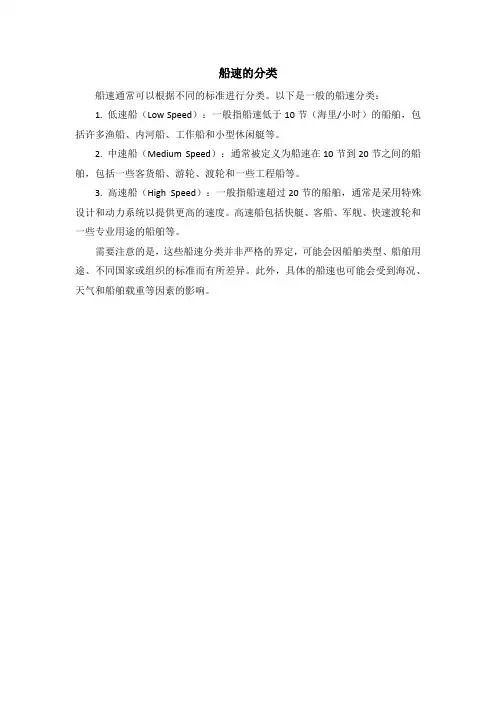
船速的分类
船速通常可以根据不同的标准进行分类。
以下是一般的船速分类:
1. 低速船(Low Speed):一般指船速低于10节(海里/小时)的船舶,包括许多渔船、内河船、工作船和小型休闲艇等。
2. 中速船(Medium Speed):通常被定义为船速在10节到20节之间的船舶,包括一些客货船、游轮、渡轮和一些工程船等。
3. 高速船(High Speed):一般指船速超过20节的船舶,通常是采用特殊设计和动力系统以提供更高的速度。
高速船包括快艇、客船、军舰、快速渡轮和一些专业用途的船舶等。
需要注意的是,这些船速分类并非严格的界定,可能会因船舶类型、船舶用途、不同国家或组织的标准而有所差异。
此外,具体的船速也可能会受到海况、天气和船舶载重等因素的影响。
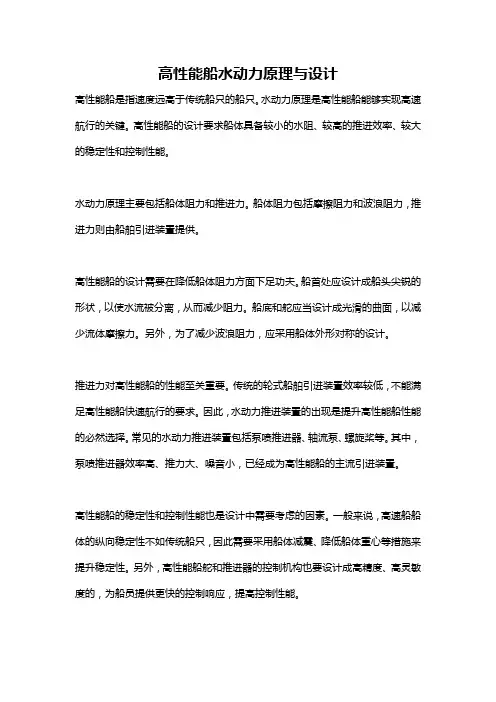
高性能船水动力原理与设计
高性能船是指速度远高于传统船只的船只。
水动力原理是高性能船能够实现高速航行的关键。
高性能船的设计要求船体具备较小的水阻、较高的推进效率、较大的稳定性和控制性能。
水动力原理主要包括船体阻力和推进力。
船体阻力包括摩擦阻力和波浪阻力,推进力则由船舶引进装置提供。
高性能船的设计需要在降低船体阻力方面下足功夫。
船首处应设计成船头尖锐的形状,以使水流被分离,从而减少阻力。
船底和舵应当设计成光滑的曲面,以减少流体摩擦力。
另外,为了减少波浪阻力,应采用船体外形对称的设计。
推进力对高性能船的性能至关重要。
传统的轮式船舶引进装置效率较低,不能满足高性能船快速航行的要求。
因此,水动力推进装置的出现是提升高性能船性能的必然选择。
常见的水动力推进装置包括泵喷推进器、轴流泵、螺旋桨等。
其中,泵喷推进器效率高、推力大、噪音小,已经成为高性能船的主流引进装置。
高性能船的稳定性和控制性能也是设计中需要考虑的因素。
一般来说,高速船船体的纵向稳定性不如传统船只,因此需要采用船体减震、降低船体重心等措施来提升稳定性。
另外,高性能船舵和推进器的控制机构也要设计成高精度、高灵敏度的,为船员提供更快的控制响应,提高控制性能。
综上所述,水动力原理对高性能船的设计具有重要影响,优化船体形状、采用高效的水动力推进装置以及提升稳定性和控制性能等措施将为高性能船的实现提供有力的支持。
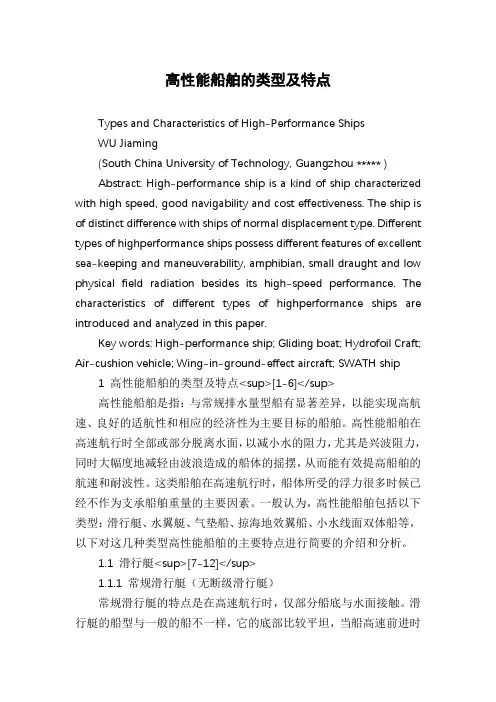
高性能船舶的类型及特点Types and Characteristics of High-Performance ShipsWU Jiaming(South China University of Technology, Guangzhou ***** )Abstract: High-performance ship is a kind of ship characterized with high speed, good navigability and cost effectiveness. The ship is of distinct difference with ships of normal displacement type. Different types of highperformance ships possess different features of excellent sea-keeping and maneuverability, amphibian, small draught and low physical field radiation besides its high-speed performance. The characteristics of different types of highperformance ships are introduced and analyzed in this paper.Key words: High-performance ship; Gliding boat; Hydrofoil Craft; Air-cushion vehicle; Wing-in-ground-effect aircraft; SWATH ship1 高性能船舶的类型及特点<sup>[1-6]</sup>高性能船舶是指:与常规排水量型船有显著差异,以能实现高航速、良好的适航性和相应的经济性为主要目标的船舶。
高性能船舶动力装置发展前景高性能船舶动力装置是指能够提供强劲动力、提高船舶速度和效率的装置。
随着航运业的发展和技术的不断进步,高性能船舶动力装置的发展前景十分广阔。
高性能船舶动力装置的发展将会提高船舶的速度和效率。
传统船舶通常使用柴油发动机作为动力装置,但其速度和效率相对较低。
而高性能船舶动力装置采用先进的技术和材料,可以提供更高的功率输出,从而提高船舶的速度和效率。
这对于运输业和军事舰船来说都是非常有吸引力的,可以降低航行时间、提高运输效率、增强军事作战能力。
高性能船舶动力装置的发展将会降低能源消耗和环境污染。
随着全球环境问题的日益突出,对能源消耗和环境影响的要求也越来越高。
高性能船舶动力装置通常采用先进的燃料电池、氢能源、气轮机等技术,可以大幅度降低能源消耗和减少废气排放,从而减少对环境的污染。
这不仅符合经济可持续发展的要求,也有利于保护海洋生态环境。
高性能船舶动力装置的发展将推动船舶工业的升级和产业链的延伸。
高性能船舶动力装置是船舶的核心设备之一,其发展需要大量的研发和生产资源。
随着高性能船舶动力装置市场的扩大,将有更多的企业投入到这一领域,这将促进船舶工业的技术升级和生产能力的发展。
与此高性能船舶动力装置的发展也将推动相关产业链的延伸,带动船舶配套设备、船舶维修维护等相关产业的发展。
高性能船舶动力装置的发展将推动航运业的创新和竞争力的提升。
高性能船舶动力装置的出现将促使航运企业在船舶技术上进行创新,以适应市场需求和提高竞争力。
航运企业将倾向于购买和采用高性能船舶动力装置,以提高船舶的速度和效率,减少能源消耗和环境污染,从而降低成本、提高运输效率、提升市场竞争力。
高性能船舶动力装置的发展前景十分广阔。
它不仅可以提高船舶的速度和效率,降低能源消耗和环境污染,推动船舶工业的升级和产业链的延伸,还可以推动航运业的创新和竞争力的提升。
高性能船舶动力装置的研发和推广具有重要的意义和潜在的市场价值。
§1-8 几种高性能船舶
一、滑行艇
二、水翼艇
几种水翼示意图
图1-8-1 水翼艇
三、气垫船
1.全垫升式气垫船
ACV=air cushion vehicle (hovercraft)
全垫升式气垫船,气垫运输器,用空气动力机推进。
图1-8-2 全垫升式气垫船
2.侧壁式气垫船
SES=surface effect ship
侧壁式或侧体式,可用水推进器如螺旋桨或喷水
推进
图1-8-3 侧壁式气垫船
四、地效翼船
五、其它高性能船舶
其它高性能船舶包括有深V型舰船、多体船、小水线面双体船、穿浪船等。
图1-8-4 小水线面双体半潜船
复习思考题
1.船舶有哪些分类方法?
2.民用船舶主要包括哪些?各自的任务、特点是
什么?
3.军用舰艇主要包括哪些?它们的使命是什么?
主要战斗舰艇的主要武备是什么?
4.哪些是发展中的高速船艇?特点如何?
5.。
高性能船舶的定义
高性能船舶是为突破常规船舶性能和适应特殊环境要求而开发的,具有某些特殊性能的船舶。
它们具有高航速、浅吃水、耐波性、两栖性,或兼而有之。
这些船舶多为短程高速小型船舶,主要用作内河和沿海客运、交通、观光、游览和救生等。
按作用原理和特性,主要分为气垫船、水翼船、滑行艇、高速单体船、双体船、冲翼艇、飞翼艇等,其中气垫船又分为全垫升式和侧壁式,它们与冲翼艇和飞翼艇同为空气静(动)力支撑船;水翼船又分为割划式水翼船和全浸式水翼船,它们与滑行艇同为水动力支撑;双体船又分为高速双体船和小水线面双体船,它们与单体高速船同为水静力支撑。
来源网络整理,仅供学习参考 1。
高性能船舶动力装置发展前景
近年来,随着人们对船舶行业的需求不断增长,如高速运输、深海勘探、海洋科研等,对船舶动力装置的要求也越来越高。
高性能船舶动力装置发展前景广阔,将在船舶领域发
挥重要作用。
高性能船舶动力装置具有高效能的特点,能够提供更大的动力输出。
随着船舶尺寸的
不断增大,对动力的需求也越来越大。
传统的船舶动力装置难以满足如此高强度的工作要求,而高性能船舶动力装置能够利用高效能的设备和技术,提供更大的功率输出,满足船
舶运行的需求。
这将在大型远洋船舶和深海勘探船等领域得到广泛应用。
高性能船舶动力装置具有低污染的特点,能够满足环保要求。
随着环保意识的不断提高,船舶行业也面临着对排放标准的要求越来越严格的挑战。
高性能船舶动力装置采用了
先进的燃烧技术和污染控制技术,能够减少废气和废水的排放,大大降低了对环境的影响。
这将在环保船舶和海洋保护等领域得到广泛应用。
高性能船舶动力装置具有安全可靠的特点,能够保障船舶的安全运营。
船舶行业的发
展离不开安全运营。
高性能船舶动力装置利用先进的技术和材料,提高了装置的安全性和
可靠性,降低了事故发生的概率。
这将在海上救援船和海上施工船等领域得到广泛应用。
High speed vessels of semi-displacement type are often equipped with appendages such as trim tabs, stern flaps and wedges to control the trim angle and improve the resistance performance. However, dynamic instability can be occurred if dimensions of those appendages are not suitable for the hull. So it is important to predict effects of appendages on the running attitudes of a vessel and choose proper dimensions of appendages at initial design stage. There are many researchers that calculate running attitudes of high speed vessels in calm water and in waves. Especially, steady states of prismatic planning hulls were theoretically predicted in some previous researches. In this paper, running attitudes of a semi-displacement vessel are predicted by theoretical methods, and model tests are carried out to verify theoretical calculations. Present calculations are based on previous formulas for prismatic planning hulls and developed to be applied to semi-displacement round bilge vessels. High speed model tests for the vessel with various trim tabs are performed in Seoul National University towing tank. Vertical motions in calm water are measured at various Froude numbers, and those are compared with calculation, results.Running attitudes of semi-displacement vessels are significantly changed at high speed and thus have an effect on resistance performance and stability of the vessel. There have been many theoretical approaches about the prediction of running attitudes of high-speed vessels in calm water. Most of them proposed theoretical formulations for the prismatic hard-chine planing hull. In this paper, running attitudes of a semi-displacement round bilge vessel are theoretically predicted and verified by high-speed model tests. Previous calculation methods for hard-chine planing vessels are extended to be applied to semi-displacement round bilge vessels. Force and moment components acting on the vessel are estimated in the present iteration program. Hydrodynamic forces are calculated by 'added mass planing theory', and near-transom correction function is modified to be suitable to a semi-displacement vessel. Next, 'plate pressure distribution method' is proposed as a new hydrodynamic force calculation method. Theoretical pressure model of the 2-dimensional flat plate is distributed on the instantaneous waterplane corresponding to the attitude of the vessel, and hydrodynamic force and moment are estimated by integration of those pressures. Calculations by two methods show good agreements with experimental results.The Effect of Appendages on the Course Keeping Ability of a Semi-DisplacementRound Bilge Ship0推荐请求原文传递导出分享到|It has been often reported that water-jet propelled high speed vessels lost the course keeping ability in seaway. In this study, model tests were performed to measure the running attitude and to check the course keeping ability of a high speed vessel. The ship may lose the course keeping ability at high speed, the variation of running attitudes such as bow drop and heel are closely related to the dynamic instability. So model tests were carried out to improve running attitudes by changing the position of longitudinal center of gravity and by using appendages at the bow and the stern of a model. The position of lateral center of pressure moved toward stern and the course keeping ability was improved by modifying the transom wedge angleDYNAMIC BEHA VIOR OF SEMI-DISPLACEMENT AND PLANNING VESSELS IN CALM WATER AND WA VES0推荐请求原文传递导出分享到|Main topics are dynamic instabilities, slamming and global wave-induced response of semidisplacement and planning vessels. Spinout and porpoising are discussed in detail. A nonlinear porpoising analysis shows that initial instabilities can lead to steady-state heave and pitch oscillations. A 2D+t nonlinear method is applied in the analysis of porpoising and wave-induced motions and accelerations of a planning vessel in head sea. The lack of correctly predicting the 3D flow at the transom stern influences, in particular, pitch accelerations. However, a fully 3D method can also lead to numerical difficulties in describing nonlinear wave effects on high-speed vessel. The latter occurred with a recently developed computer code in predicting second-order springing excitation in incident bichromatic waves. Wetdeck slamming is given special attention.THE RESISTANCE AND TRIM OF SEMI-DISPLACEMENT,DOUBLE-CHINE, TRANSOM-STERN HULL SERIES0推荐请求原文传递导出分享到|A new systematic series with a focus on the resistance and seakeeping characteristics, as well as the hull simplicity, was developed in the NTUA. The Series is primarily intended to be used for large high-speed vessels operating at speeds corresponding to F_N=0.5 to 0.9. Series main parameters and their ranges are the following: L/B=4.3-7.5, (M)=6.2-10.0, B/T=3.2-6.2, C_B=0.34-0.54, and LCB= -(12.4-14.6)%L. Regression analysis is used to establish a predictive technique and a mathematical representation of resistance and trim is provided. C_R and τ are chosen to be dependent variables, while L/B, (M), B/T and F_N are the independent ones. The mathematical models are suitable for implementation in software and can replace the "manual" power prediction calculations for the NTUA series.THE RESISTANCE AND TRIM OF SEMI-DISPLACEMENT, DOUBLE-CHINE, TRANSOM-STERN HULL SERIES0推荐请求原文传递导出分享到|A new systematic series with a focus on the resistance and seakeeping characteristics, as well as the hull simplicity, was developed in the NTUA. The Series is primarily intended to be used for large high-speed vessels operating at speeds corresponding to F_N=0.5 to 0.9. Series main parameters and their ranges are the following: L/B=4.3-7.5, (M)=6.2-10.0, B/T=3.2-6.2, C_B=0.34-0.54, and LCB=-(12.4-14.6)%L. Regression analysis is used to establish a predictive technique and a mathematical representation of resistance and trim is provided. C_R and τ are chosen to be dependent variables, while L/B, (M), B/T and F_N are the independent ones. The mathematical models are suitable for implementation in software and can replace the "manual" power prediction calculations for the NTUA series.Experimental and CFD Study of Wave Resistance of High-Speed Round Bilge Catamaran Hull Forms0推荐请求原文传递导出分享到|Although catamaran configuration has been around for a longtime, it is only in the recent past that such hull forms have seen unprecedented growth in the high-speed ferry industry. One of the design challenges faced by naval architects is accurate prediction of the hydrodynamic characteristics of such vessels primarily in the areas of resistance, propulsion and seakeeping. Even though considerable amount of research has been carried out in this area, there remains a degree of uncertainty in the prediction of calm water resistance of catamaran hull forms. This research attempts to examine the calm water wave resistance characteristics of a series of round bilge transom stern, semi-displacement slender catamaran hull forms based on computational fluid dynamics (CFD) modeling. While maintaining the same center of buoyancy and displacement, the influence of hull shape has been examined, specifically the effects of demi-hull spacing in the speed range corresponding to Froude numbers of 0.2 to 1.0. The results of CFD analysis have been compared with experimental towing tank results of NPL series, which closely resemble the systematic series developed here. The results obtained show considerable promise and development of an industry standard regression equation based on the data obtained from CFD analysis, model experiments and full-scale ship trials, can be seen as achievable.HIGH-SPEED MILITARY SEALIFT A RE-EXAMINATION OF OPTIONS0推荐请求原文传递导出分享到|Following the Gulf War, a focus for the US Military has been the transportation of military hardware from its home base or fort to the battle zone or foxhole in the most expedient way possible. One option was to re-examine the feasibility of higher speed military sealift that can take advantage of the significant recent trends occurring with high-speed commercial vessels. This paper serves to examine this possibility by studying emerging hullform technologies that could have both commercial viability and military feasibility for the future. The goal was to achieve asignificant reduction (from 15 days) for the time to transit a distance of up to 8700 nm from the Continental United States (CONUS) to the theater of operations, at a cost which is competitive with prepositioning and other options. New hullform concepts assessed included slender monohulls, semi-displacement monohulls, wave-piercing catamarans, semi-SWATH, and SES. For each hullform, parametric variations of the ship dimensions and performance capabilities were examined to determine optimum and feasible configurations. To assess their significance for the military sealift mission, outer envelopes of payload versus range and speed were developed to define what was scientifically possible to achieve by these ships. Envelopes were defined for ships having system technologies that would be available in the near-term and also in ten years from now. For their significance in commercial use, the ships were then assessed on a commercial Trans-Atlantic route. Here, their economic viability serving the "middle" market was determined for which fast-ship projects are now emerging. Then, the cost effectiveness of these ships in the desired (Trans-Pacific) Army sealift scenario was assessed. The study was conducted using unique ship design concept-exploration software that has been under developed for more than 20 years. Development of this software has focused on the use of physics-based algorithms to enhance the abilSIMULATION OF A FAST CATAMARAN'S MANOEUVRING MOTION BASED ON A 6-DOF REGRESSION MODEL0推荐请求原文传递导出分享到|Some observations of the manoeuvring motion of fast displacement catamarans indicated that dynamic changes in the ship's attitude in vertical planes (sinkage, trim and heel) observed during high-speed manoeuvring can have effect on the horizontal plane hydrodynamic forces and on the dynamic properties of these vessels. However, merely all catamaran manoeuvring simulations carried out so far were based on simplified 3DOF mathematical models. In the present study, used were regression models for all 6 components of the hull forces with account for the influence of the attitude alteration effects previously developed on the basis of Computerized Planar Motion Carriage captive-model tests. Basing on these regressions, a relatively complete 6DOF manoeuvring mathematical model was developed for a particular river-going catamaranequipped with steered water-jets. Certain components of the hydrodynamic force, which could not be determined from the captive-model tests, were estimated by means of the slender-body theory, the cross-flow drag concept and other semi-empiric approaches. Standard manoeuvres were simulated using both the 6DOF and 3DOF mathematical models. The results were compared with the available full-scale data and this comparison indicated that the 6DOF modelling becomes really more adequate at higher speed.。